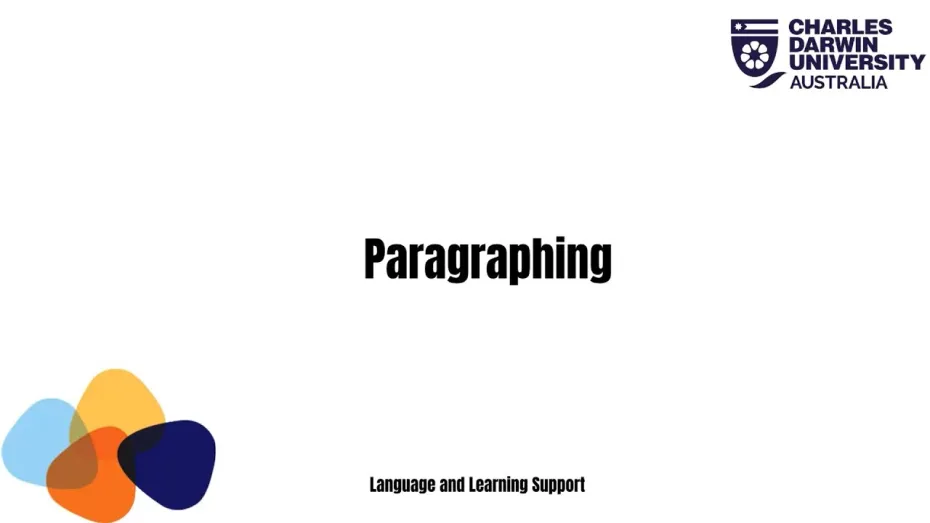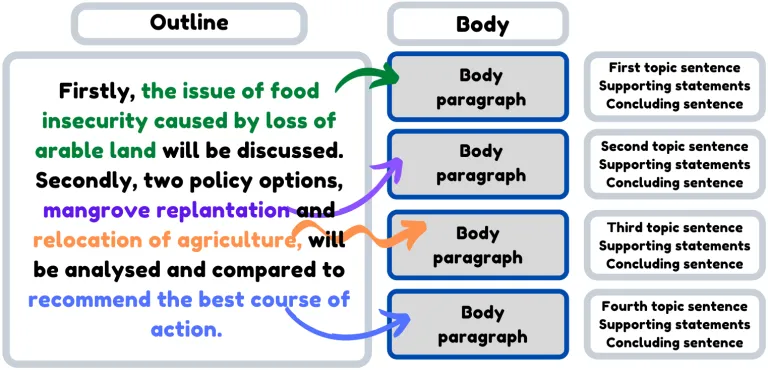A paragraph is a group of sentences about a particular idea. Paragraphs are the building blocks of longer texts. How you organise and sequence your paragraphs can help your reader understand the development of your ideas in your written assignments.
This page will help you to meet your lecturers' expectations by:
self evaluating your strengths and weaknesses
considering the purpose and features of paragraphs
writing clear, well-structured paragraphs in your assignments.
Download this summary for your reference.
Introduction to effective paragraphs
Whether you need to write an essay, an annotated bibliography, a reflection, or any of the many genres that are common at university, you need to use effective paragraphing.
Self evaluation
Before you continue, reflect on your previous writing experiences and the feedback you have received. How would you rate your ability in the following skills? Rate your ability from ‘good’ to ‘needs development’.
Reflect on your answers. Congratulations if you feel confident about your skills. You may find it helpful to review the materials on this page to confirm your knowledge and possibly learn more. Don't worry if your skills need development. All students must learn academic skills and these materials will help you.
The purpose and organisation of paragraphs
Watch the video to learn more about paragraphs.
Check your learning. Decide if these statements about paragraphs are true or false.
Now, work through the materials to develop your skills.
Paragraphs and cohesion
In Essays, you learn that paragraphs follow the order of the outline given in your introductions. This makes your writing cohesive; that is, how you sequence your paragraphs can help make your essays well-organised and easy to read.
Likewise, your paragraphs should also be cohesive. The aim of the next task is to explore how paragraphs function overall. Read the paragraph about drone use.
- Think: What is the purpose of each sentence?
- Check your answers by clicking on the hotspots.
Consider what you have learned about paragraphs so far. Put these sentences into order to create a logically ordered and cohesive paragraph.
Compare your answers with this analysis.
The elements of paragraphs
This section will help you to effectively structure your paragraphs.
An overview
Your written assignments at university mostly have a three-part structure: introduction, body and conclusion. Each element is made up of paragraphs. Many paragraphs also have a three-part structure known as TEEL/C.
| T | means topic. |
| E | means explanation, elaboration, evidence, example. |
| L/C | means link or conclusion (optional). |
The next sections will look at each element in turn.
Writing topic sentences
Remember that topic sentences must:
introduce the topic of the paragraph
introduce the controlling idea – or what aspect of the topic you will discuss.
Read the following paragraph extracts and choose the best topic sentences.
Writing the body
In the body of your paragraph, you will
explain or elaborate on your ideas and/or
provide evidence or examples in support of your ideas.
Your evidence often includes facts and ideas paraphrased from published research and referenced. If you would like to revise these skills, visit Summarising, generalising, paraphrasing and quoting.
Remember, the body sentences use explanation, elaboration and evidence to create strong support for the controlling idea presented in the topic sentence.
- Read the paragraph and identify the function of each of the body sentences.
- Check your answers by clicking on the hotspots.
Remember, always acknowledge your sources. Be very careful with referencing. The referencing style that you use depends on the expectations of your lecturer, so always check first.
Concluding the paragraph
Remember, not every paragraph has an obvious conclusion. This is because paragraphs are part of a longer text, not distinct, separate items. However, you may choose to:
add a concluding comment on the topic or evidence
conclude with a summary statement
link forward to the next paragraph.
Read the paragraph.
You will be shown three possible concluding sentences. Match each one with the function that it performs.
Applying your learning
Reflect on what you have learned in this material and consider how you can use it in your own work.
Steps to writing an effective paragraph
Even though paragraphs are short, you must still write them with care. Follow these steps to write effective paragraphs.
- Plan the point you want to discuss. What do you want to say and how will you support your point?
- Use a clear structure which introduces and logically develops one idea at a time. For example, a common paragraph structure is TEEL/C.
- Start with your topic sentence.
- Develop the next few sentences by explaining, elaborating on, or providing evidence or examples to support your point.
- End the paragraph either concluding the point or linking the point to the next paragraph.
- Review your paragraph and the support. If you have used a citation to support your point, ensure it is formatted correctly.
Useful strategies
| Use available tools to help you remember to use clear structure when you write. |
|
| Read a draft that you are currently writing for one of your units. |
|
| Exchange drafts with a peer and check each other's paragraphing. |
|
Next steps
Reflect on your learning.
1 | Revisit the self-analysis quiz at the top of the page. How would you rate your skills now? |
2 | Remember that writing is a process and mistakes aren't a bad thing. They are a normal part of learning and can help you to improve. |
If you would like more support, visit the Language and Learning Advisors page.
We value your opinion. Please click on the button to share your feedback on these materials. |
Did you know CDU Language and Learning Advisors offer a range of study support options?
https://www.cdu.edu.au/library/language-and-learning-support




